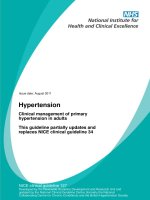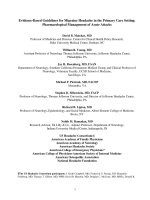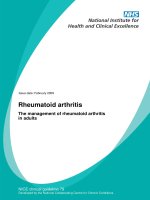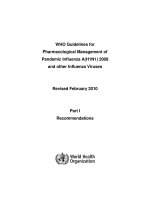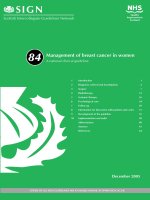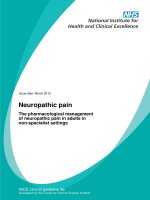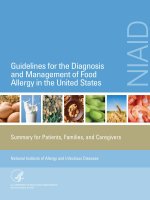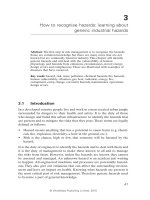Neuropathic pain - The pharmacological management of neuropathic pain in adults in non-specialist settings pot
Bạn đang xem bản rút gọn của tài liệu. Xem và tải ngay bản đầy đủ của tài liệu tại đây (1.68 MB, 155 trang )
Issue date: March 2010
NICE clinical guideline 96
Developed by the Centre for Clinical Practice at NICE
Neuropathic pain
The pharmacological management
of neuropathic pain in adults in
non-specialist settings
NICE clinical guideline 96
Neuropathic pain: the pharmacological management of neuropathic pain
in adults in non-specialist settings
Ordering information
You can download the following documents from
www.nice.org.uk/guidance/CG96
The full guideline (this document) – all the recommendations, details of how
they were developed, and reviews of the evidence they were based on.
A quick reference guide – a summary of the recommendations for
healthcare professionals.
‘Understanding NICE guidance’ – a summary for patients and carers.
For printed copies of the quick reference guide or ‘Understanding NICE
guidance’, phone NICE publications on 0845 003 7783 or email
and quote:
N2115 (quick reference guide)
N2116 (‘Understanding NICE guidance’).
NICE clinical guidelines are recommendations about the treatment and care of
people with specific diseases and conditions in the NHS in England and
Wales.
This guidance represents the view of NICE, which was arrived at after careful
consideration of the evidence available. Healthcare professionals are
expected to take it fully into account when exercising their clinical judgement.
However, the guidance does not override the individual responsibility of
healthcare professionals to make decisions appropriate to the circumstances
of the individual patient, in consultation with the patient and/or guardian or
carer, and informed by the summary of product characteristics of any drugs
they are considering.
Implementation of this guidance is the responsibility of local commissioners
and/or providers. Commissioners and providers are reminded that it is their
responsibility to implement the guidance, in their local context, in light of their
duties to avoid unlawful discrimination and to have regard to promoting
equality of opportunity. Nothing in this guidance should be interpreted in a way
that would be inconsistent with compliance with those duties.
National Institute for Health and Clinical Excellence
MidCity Place
71 High Holborn
London WC1V 6NA
www.nice.org.uk
© National Institute for Health and Clinical Excellence, 2010. All rights reserved. This material
may be freely reproduced for educational and not-for-profit purposes. No reproduction by or
for commercial organisations, or for commercial purposes, is allowed without the express
written permission of NICE.
Contents
Disclaimer 5
How to read this guideline 6
Introduction 7
Patient-centred care 10
1 Summary 11
1.1 List of all recommendations 12
1.2 Care pathway 18
1.3 Overview 22
2 How this guideline was developed 25
2.1 Introduction 25
2.1.1 Pharmacological treatments, key outcomes and analysis 25
2.1.2 Health economics 32
2.1.3 Summaries of included studies 33
2.2 Evidence statements 39
2.2.1 Antidepressants 39
2.2.2 Anti-epileptics 42
2.2.3 Opioids 47
2.2.4 Topical treatments 49
2.2.5 Comparative trials and combination therapy 51
2.2.6 Health economics evidence statements 58
2.3 Clinical evidence reviews 59
2.3.1 Antidepressants as monotherapy for neuropathic pain 59
2.3.2 Anti-epileptics as monotherapy for neuropathic pain 65
2.3.3 Opioid analgesics as monotherapy for neuropathic pain 77
2.3.4 Topical capsaicin and topical lidocaine as monotherapy for
neuropathic pain 82
2.3.5 Comparative trials on pharmacological treatments and combination
therapy for neuropathic pain 87
2.4 Health economics evidence review 101
2.4.1 HTA report: methods 103
2.4.2 HTA report: results 108
2.4.3 Discussion 111
2.5 Evidence to recommendations 118
2.5.1 Antidepressants 118
2.5.2 Anti-epileptics 121
2.5.3 Opioids 124
2.5.4 Topical treatments 126
2.5.5 Comparative and combination trials 127
2.5.6 Key principles of care 129
2.6 Recommendations 130
3 Research recommendations 135
3.1 Carbamazepine for treating trigeminal neuralgia 135
3.2 Monotherapy versus combination therapy for treating neuropathic
pain 136
3.3 Factors influencing quality of life of people with neuropathic pain . 137
3.4 Relationship between cause of neuropathic pain and its treatment
137
4 Other versions of this guideline 138
5 Related NICE guidance 138
6 Updating the guideline 139
7 References, glossary and abbreviations 139
7.1 References 139
7.2 Glossary 149
7.3 Abbreviations 151
8 Contributors 152
8.1 The Guideline Development Group 152
8.2 The short clinical guidelines technical team 153
8.3 The Guideline Review Panel 154
8.4 Declarations of interest 155
8.5 Authorship and citation 155
NICE clinical guideline 96 – Neuropathic pain 5
Disclaimer
NICE clinical guidelines are recommendations about the treatment and care of
people with specific diseases and conditions in the NHS in England and
Wales.
This guidance represents the view of NICE, which was arrived at after careful
consideration of the evidence available. Healthcare professionals are
expected to take it fully into account when exercising their clinical judgement.
However, the guidance does not override the individual responsibility of
healthcare professionals to make decisions appropriate to the circumstances
of the individual patient, in consultation with the patient and/or guardian or
carer.
Implementation of this guidance is the responsibility of local commissioners
and/or providers. Commissioners and providers are reminded that it is their
responsibility to implement the guidance, in their local context, in light of their
duties to avoid unlawful discrimination and to have regard to promoting
equality of opportunity. Nothing in this guidance should be interpreted in a way
that would be inconsistent with compliance with those duties.
NICE clinical guideline 96 – Neuropathic pain 6
How to read this guideline
In this guideline, most of the information about the evidence is included in
chapter 2. Details of which pharmacological treatments (table 2) and
neuropathic pain conditions (table 3) were considered, as well as a summary
of the characteristics of all included studies (table 5), are given in section 2.1.
The evidence statements (section 2.2) are the overall descriptive summary of
the evidence. Each evidence statement is linked to an evidence review, which
is presented as a GRADE profile (section 2.3). Each GRADE profile includes
the characteristics of the evidence, the detailed results for the primary
outcomes and a description of the quality of the evidence. Detailed evidence
tables are included in appendix 10.9. The health economics evidence review,
including a summary of a relevant Health Technology Assessment (HTA)
1
report, is described in section 2.4.
The evidence to recommendations section (section 2.5) captures all of the
discussion by the Guideline Development Group (GDG) about the quality of
the evidence, and outlines how the GDG reached decisions, based on the
evidence or on consensus, to make specific recommendations.
The recommendations are listed both in section 1.1 (at the start of the
guideline) and again in section 2.6 (towards the end of the guideline).
1
Fox-Rushby JA, GL Griffith, JR Ross et al. (2010) The clinical and cost-effectiveness of
different treatment pathways for neuropathic pain [NP]. NIHR Health Technology Assessment
(HTA) programme, ref. 05/30/03. In press. Project abstract available from
www.hta.ac.uk/1527
NICE clinical guideline 96 – Neuropathic pain 7
This clinical guideline updates and replaces the following recommendations
on the drug treatment of painful diabetic neuropathy in previous NICE clinical
guidelines:
recommendations 1.11.5.2, 1.11.5.3, 1.11.5.4, 1.11.5.5 and 1.11.5.7 in
‘Type 1 diabetes: diagnosis and management of type 1 diabetes in
children, young people and adults’ (NICE clinical guideline 15)
recommendations 1.14.2.3, 1.14.2.4, 1.14.2.5 and 1.14.2.6 in ‘Type 2
diabetes: the management of type 2 diabetes’ (NICE clinical guideline 87).
Introduction
Neuropathic pain develops as a result of damage to, or dysfunction of, the
system that normally signals pain. It may arise from a heterogeneous group of
disorders that affect the peripheral and central nervous systems. Common
examples include painful diabetic neuropathy, post-herpetic neuralgia and
trigeminal neuralgia. People with neuropathic pain may experience altered
pain sensation, areas of numbness or burning, and continuous or intermittent
evoked or spontaneous pain. Neuropathic pain is an unpleasant sensory and
emotional experience that can have a significant impact on a person’s quality
of life.
Neuropathic pain is often difficult to treat, because it is resistant to many
medications and/or because of the adverse effects associated with effective
medications. A number of drugs are used to manage neuropathic pain,
including antidepressants, anti-epileptic (anticonvulsant) drugs, opioids and
topical treatments such as capsaicin and lidocaine. Many people require
treatment with more than one drug, but the correct choice of drugs, and the
optimal sequence for their use, has been unclear.
Clinicians may be guided by a number of published guidelines and algorithms
for the management of neuropathic pain, but these are not consistent
regarding the choice of drug treatment. This may lead to variation in practice
in terms of which therapy is started, how this is done, whether therapeutic
doses are achieved and whether the different types of drugs are used in the
NICE clinical guideline 96 – Neuropathic pain 8
correct sequence. Furthermore, guidelines on the management of neuropathic
pain rarely include considerations of cost effectiveness. An ongoing
systematic review of different treatment pathways for neuropathic pain,
commissioned by the National Institute for Health Research (NIHR) Health
Technology Assessment (HTA) programme and due to report in 2010
2
, was
used to inform this guideline where appropriate.
This clinical guideline covers the management of neuropathic pain conditions
in adults (aged 18 or over) in primary care and secondary care, excluding
specialist pain management clinics. The aim of the guideline is to provide
clear recommendations to healthcare professionals in non-specialist settings
on the treatment and management of neuropathic pain. This includes
recommendations on appropriate and timely referral to specialist pain services
and/or condition-specific services
3
. In general, regarding neuropathic pain as
a ‘blanket condition’, irrespective of the underlying cause, is helpful and
practical for both non-specialist healthcare professionals and patients.
However, condition-specific recommendations and research
recommendations have been made where robust evidence on clinical and
cost effectiveness exists for specific conditions, or where the evidence is
clearly uncertain. The guideline excludes acute pain arising directly (in the first
3 months) from trauma or orthopaedic surgical procedures.
For all drugs, recommendations are based on evidence of clinical and cost
effectiveness and reflect whether their use for the management of neuropathic
pain is a good use of NHS resources. This guideline should be used in
conjunction with clinical judgement and decision-making appropriate for the
individual patient.
The guideline will assume that prescribers will use a drug’s summary of
product characteristics (SPC) and the British National Formulary (BNF) to
2
Fox-Rushby JA, GL Griffith, JR Ross et al. (2010) The clinical and cost-effectiveness of
different treatment pathways for neuropathic pain [NP]. NIHR Health Technology Assessment
(HTA) programme, ref. 05/30/03. In press. Project abstract available from
www.hta.ac.uk/1527
3
A condition-specific service is a specialist service that provides treatment for the underlying
health condition that is causing neuropathic pain. Examples include neurology, diabetology
and oncology services.
NICE clinical guideline 96 – Neuropathic pain 9
inform decisions made with individual patients (this includes obtaining
information on special warnings, precautions for use, contraindications and
adverse effects of pharmacological treatments). However, the Guideline
Development Group (GDG) agreed that having clear statements on drug
dosage and titration in the actual recommendations is crucial for treatment in
non-specialist settings, to emphasise the importance of titration to achieve
maximum benefit.
This guideline recommends some drugs for indications for which they do not
have a UK marketing authorisation at the date of publication, if there is good
evidence to support that use. When recommendations have been made for
the use of drugs outside their licensed indications (‘off-label’ use), these drugs
are marked with an asterisk in the recommendations. Licensed indications are
listed in table 1.
Table 1 Licensed indications for recommended pharmacological
treatments for neuropathic pain (March 2010)
Amitriptyline
Not licensed for neuropathic pain
Duloxetine
Licensed for painful diabetic neuropathy
Imipramine
Not licensed for neuropathic pain
Lidocaine (topical)
Licensed for post-herpetic neuralgia
Nortriptyline
Not licensed for neuropathic pain
Pregabalin
Licensed for central and peripheral neuropathic
pain
Tramadol
Licensed for moderate and severe pain
NICE clinical guideline 96 – Neuropathic pain 10
Patient-centred care
This guideline offers best practice advice on the pharmacological
management of neuropathic pain in adults in non-specialist settings.
Treatment and care should take into account patients’ needs and preferences.
People with neuropathic pain should have the opportunity to make informed
decisions about their care and treatment, in partnership with their healthcare
professionals. If patients do not have the capacity to make decisions,
healthcare professionals should follow the Department of Health's advice on
consent (available from www.dh.gov.uk/consent) and the code of practice that
accompanies the Mental Capacity Act (summary available from
www.publicguardian.gov.uk). In Wales, healthcare professionals should follow
advice on consent from the Welsh Assembly Government (available from
www.wales.nhs.uk/consent).
Good communication between healthcare professionals and patients is
essential. It should be supported by evidence-based written information
tailored to the patient’s needs. Treatment and care, and the information
patients are given about it, should be culturally appropriate. It should also be
accessible to people with additional needs such as physical, sensory or
learning disabilities, and to people who do not speak or read English.
If the patient agrees, families and carers should have the opportunity to be
involved in decisions about treatment and care.
Families and carers should also be given the information and support they
need.
NICE clinical guideline 96 – Neuropathic pain 11
1 Summary
The recommendations in this clinical guideline are for the pharmacological
management of neuropathic pain in non-specialist settings only. The
Guideline Development Group acknowledged that there are other
pharmacological and non-pharmacological treatments that will be of benefit to
people with neuropathic pain, within different care pathways in different
settings. However, the purpose of this clinical guideline is to provide useful
and practical recommendations on pharmacological management in non-
specialist settings for both people with neuropathic pain and healthcare
professionals.
The following definitions apply to this guideline.
Non-specialist settings Primary and secondary care services that do not
provide specialist pain services. Non-specialist settings include general
practice, general community care and hospital care.
Specialist pain services Services that provide comprehensive
assessment and multi-modal management of all types of pain, including
neuropathic pain.
NICE clinical guideline 96 – Neuropathic pain 12
1.1 List of all recommendations
Key principles of care
1.1.1 Consider referring the person to a specialist pain service and/or a
condition-specific service
4
at any stage, including at initial
presentation and at the regular clinical reviews (see
recommendation 1.1.9), if:
they have severe pain or
their pain significantly limits their daily activities and
participation
5
or
their underlying health condition has deteriorated.
1.1.2 Continue existing treatments for people whose neuropathic pain is
already effectively managed
6
.
1.1.3 Address the person’s concerns and expectations when agreeing
which treatments to use by discussing:
the benefits and possible adverse effects of each
pharmacological treatment
why a particular pharmacological treatment is being offered
coping strategies for pain and for possible adverse effects of
treatment
that non-pharmacological treatments are also available in non-
specialist settings and/or through referral to specialist services
(for example, surgical treatments and psychological therapies).
4
A condition-specific service is a specialist service that provides treatment for the underlying
health condition that is causing neuropathic pain. Examples include neurology, diabetology
and oncology services.
5
The World Health Organization ICF (International Classification of Functioning, Disability and
Health) (2001) defines participation as ‘A person’s involvement in a life situation.’ It includes
the following domains: learning and applying knowledge, general tasks and demands,
mobility, self-care, domestic life, interpersonal interactions and relationships, major life areas,
community, and social and civil life.
6
Note that there is currently no good-quality evidence on which to base specific
recommendations for treating trigeminal neuralgia. The GDG expected that current routine
practice will continue until new evidence is available (see also section 3.1).
NICE clinical guideline 96 – Neuropathic pain 13
1.1.4 When selecting pharmacological treatments, take into account:
the person’s vulnerability to specific adverse effects because of
comorbidities
safety considerations and contraindications as detailed in the
SPC
patient preference
lifestyle factors (such as occupation)
any mental health problems (such as depression and/or
anxiety
7
)
any other medication the person is taking.
1.1.5 Explain both the importance of dosage titration and the titration
process, providing written information if possible.
1.1.6 When withdrawing or switching treatment, taper the withdrawal
regimen to take account of dosage and any discontinuation
symptoms.
1.1.7 When introducing a new treatment, consider overlap with the old
treatments to avoid deterioration in pain control.
1.1.8 After starting or changing a treatment, perform an early clinical
review of dosage titration, tolerability and adverse effects to assess
the suitability of the chosen treatment.
1.1.9 Perform regular clinical reviews to assess and monitor the
effectiveness of the chosen treatment. Each review should include
assessment of:
pain reduction
adverse effects
7
Refer if necessary to ‘Anxiety’ (NICE clinical guideline 22), ‘Depression’ (NICE clinical
guideline 90) and/or ‘Depression in adults with a chronic physical health problem’ (NICE
clinical guideline 91) (available at www.nice.org.uk).
NICE clinical guideline 96 – Neuropathic pain 14
daily activities and participation
8
(such as ability to work and
drive)
mood (in particular, whether the person may have depression
and/or anxiety
9
)
quality of sleep
overall improvement as reported by the person.
First-line treatment
1.1.10 Offer oral amitriptyline* or pregabalin as first-line treatment (but see
recommendation 1.1.11 for people with painful diabetic
neuropathy).
For amitriptyline*: start at 10 mg per day, with gradual upward
titration to an effective dose or the person’s maximum tolerated
dose of no higher than 75 mg per day (higher doses could be
considered in consultation with a specialist pain service).
For pregabalin: start at 150 mg per day (divided into two doses;
a lower starting dose may be appropriate for some people), with
upward titration to an effective dose or the person’s maximum
tolerated dose of no higher than 600 mg per day (divided into
two doses).
8
The World Health Organization ICF (International Classification of Functioning, Disability
and Health) (2001) defines participation as ‘A person’s involvement in a life situation.’ It
includes the following domains: learning and applying knowledge, general tasks and
demands, mobility, self-care, domestic life, interpersonal interactions and relationships, major
life areas, community, and social and civil life.
9
Refer if necessary to ‘Anxiety’ (NICE clinical guideline 22), ‘Depression’ (NICE clinical
guideline 90) and/or ‘Depression in adults with a chronic physical health problem’ (NICE
clinical guideline 91) (available at www.nice.org.uk).
* In these recommendations, drug names are marked with an asterisk if they do not have UK
marketing authorisation for the indication in question at the time of publication (March 2010).
Informed consent should be obtained and documented.
NICE clinical guideline 96 – Neuropathic pain 15
1.1.11 For people with painful diabetic neuropathy, offer oral duloxetine as
first-line treatment. If duloxetine is contraindicated, offer oral
amitriptyline*.
For duloxetine: start at 60 mg per day (a lower starting dose may
be appropriate for some people), with upward titration to an
effective dose or the person’s maximum tolerated dose of no
higher than 120 mg per day.
For amitriptyline*: see recommendation 1.1.10.
1.1.12 Based on both the early and regular clinical reviews:
if there is satisfactory improvement, continue the treatment;
consider gradually reducing the dose over time if improvement is
sustained
if amitriptyline* as first-line treatment results in satisfactory pain
reduction but the person cannot tolerate the adverse effects,
consider oral imipramine* or nortriptyline* as an alternative.
Second-line treatment
1.1.13 If satisfactory pain reduction is not achieved with first-line treatment
at the maximum tolerated dose, offer treatment with another drug
instead of or in combination with the original drug, after informed
discussion with the person.
If first-line treatment was with amitriptyline* (or imipramine* or
nortriptyline*), switch to or combine with oral pregabalin.
If first-line treatment was with pregabalin, switch to or combine
with oral amitriptyline* (or imipramine* or nortriptyline* as an
alternative if amitriptyline* is effective but the person cannot
tolerate the adverse effects; see recommendation 1.1.12).
NICE clinical guideline 96 – Neuropathic pain 16
For people with painful diabetic neuropathy:
if first-line treatment was with duloxetine, switch to
amitriptyline* or pregabalin, or combine with pregabalin
if first-line treatment was with amitriptyline*, switch to or
combine with pregabalin.
Dosage and titration should be the same as in recommendation
1.1.10.
Third-line treatment
1.1.14 If satisfactory pain reduction is not achieved with second-line
treatment:
refer the person to a specialist pain service and/or a condition-
specific service
10
and
while waiting for referral:
consider oral tramadol as third-line treatment instead of or in
combination
11
with the second-line treatment
consider topical lidocaine
12
for treatment of localised pain for
people who are unable to take oral medication because of
medical conditions and/or disability.
1.1.15 For tramadol as monotherapy, start at 50 to 100 mg not more often
than every 4 hours, with upward titration if required to an effective
dose or the person’s maximum tolerated dose of no higher than
400 mg per day. If tramadol is used as combination therapy, more
conservative titration may be required.
10
A condition-specific service is a specialist service that provides treatment for the underlying
health condition that is causing neuropathic pain. Examples include neurology, diabetology
and oncology services.
11
The combination of tramadol with amitriptyline, nortriptyline, imipramine or duloxetine is
associated with only a low risk of serotonin syndrome (the features of which include
confusion, delirium, shivering, sweating, changes in blood pressure and myoclonus).
12
Topical lidocaine is licensed for post-herpetic neuralgia, but not for other neuropathic pain
conditions.
NICE clinical guideline 96 – Neuropathic pain 17
Other treatments
1.1.16 Do not start treatment with opioids (such as morphine or
oxycodone) other than tramadol without an assessment by a
specialist pain service or a condition-specific service
10
.
1.1.17 Pharmacological treatments other than those recommended in this
guideline that are started by a specialist pain service or a condition-
specific service
10
may continue to be prescribed in non-specialist
settings, with a multidisciplinary care plan, local shared care
agreements and careful management of adverse effects.
NICE clinical guideline 96 – Neuropathic pain 18
1.2 Care pathway
The care pathway (see next page) is reproduced from the quick reference
guide for the guideline, which is available at
NICE clinical guideline 96 – Neuropathic pain 19
NICE clinical guideline 96 – Neuropathic pain 20
NICE clinical guideline 96 – Neuropathic pain 21
NICE clinical guideline 96 – Neuropathic pain 22
1.3 Overview
1.3.1 Neuropathic pain
Pain is an unpleasant sensory and emotional experience that can have a
significant impact on a person’s quality of life, general health, psychological
health, and social and economic well-being. The International Association for
the Study of Pain (IASP 2007) defines neuropathic pain as follows:
‘Pain initiated or caused by a primary lesion or dysfunction in the
nervous system. Peripheral neuropathic pain occurs when the
lesion or dysfunction affects the peripheral nervous system. Central
pain may be retained as the term for when the lesion or dysfunction
affects the central nervous system’.
Neuropathic pain is very challenging to manage because of the heterogeneity
of its aetiologies, symptoms and underlying mechanisms (Beniczky et al.
2005). Examples of common conditions that have peripheral neuropathic pain
as a symptom are painful diabetic neuropathy, post-herpetic neuralgia,
trigeminal neuralgia, radicular pain, pain after surgery and neuropathic cancer
pain (that is, chemotherapy-induced neuropathy and neuropathy secondary to
tumour infiltration). Examples of conditions that can cause central neuropathic
pain include stroke, spinal cord injury and multiple sclerosis. Neuropathic pain
can be intermittent or constant, and spontaneous or provoked. Typical
descriptions of the pain include terms such as shooting, stabbing, like an
electric shock, burning, tingling, tight, numb, prickling, itching and a sensation
of pins and needles. People may also describe symptoms of allodynia (pain
caused by a stimulus that does not normally provoke pain) and hyperalgesia
(an increased response to a stimulus that is normally painful) (McCarberg
2006).
A review of the epidemiology of chronic pain found that there is still no
accurate estimate available for the population prevalence of neuropathic pain
(Smith and Torrance 2010). For example, the prevalence of neuropathic pain
overall has been estimated at between 1% and 2%, based on summed
NICE clinical guideline 96 – Neuropathic pain 23
estimates of the prevalence in the USA (Bennett 1997) and the UK (Bowsher
et al. 1991). These estimates of population prevalence came from a number
of heterogeneous studies of variable validity, are likely to be inaccurate and
are inconsistent. Other condition-specific studies have also mirrored the
heterogeneous nature of neuropathic pain. For example, painful diabetic
neuropathy is estimated to affect between 16% and 26% of people with
diabetes (Jensen et al. 2006; Ziegler 2008). Prevalence estimates for post-
herpetic neuralgia range from 8% to 19% of people with herpes zoster when
defined as pain at 1 month after rash onset, and 8% when defined as pain at
3 months after rash onset (Schmader 2002). The development of chronic pain
after surgery is also fairly common, with estimates of prevalence ranging from
10% to 50% after many common operations (Shipton 2008). This pain is
severe in between 2% and 10% of this subgroup of patients, and many of the
clinical features closely resemble those of neuropathic pain (Jung et al. 2004;
Mikkelsen et al. 2004; Kehlet et al. 2006). Furthermore, a study of 362,693
computerised records in primary care from the Netherlands estimated the
annual incidence of neuropathic pain in the general population to be almost
1% (Dieleman et al. 2008). This considerable variability in estimates of the
prevalence and incidence of neuropathic pain and similar conditions from
general population studies is likely to be because of differences in the
definitions of neuropathic pain, methods of assessment and patient selection
(Smith and Torrance 2010).
Currently, a number of pharmacological treatments are commonly used in the
UK to manage neuropathic pain in non-specialist settings. However, there is
considerable variation in practice in terms of how treatment is initiated,
whether therapeutic doses are achieved and whether there is correct
sequencing of therapeutic classes. This may lead to inadequate pain control,
with considerable morbidity. In the context of this guideline, non-specialist
settings are defined as primary and secondary care services that do not
provide specialist pain services. These include general practice, general
community care and hospital care. Commonly used pharmacological
treatments include antidepressants (tricyclic antidepressants [TCAs], selective
serotonin reuptake inhibitors [SSRIs] and serotonin–norepinephrine reuptake
NICE clinical guideline 96 – Neuropathic pain 24
inhibitors [SNRIs]), anti-epileptic (anticonvulsant) drugs (such as gabapentin,
pregabalin and carbamazepine), topical treatments (such as capsaicin and
lidocaine) and opioid analgesics. All of these drug classes are associated with
disadvantages, as well as potential benefits. A further issue is that a number
of commonly used treatments (such as amitriptyline) are unlicensed for
treatment of neuropathic pain, which may limit their use by practitioners.
There is also uncertainty about which drugs should be used initially (first-line
treatment) for neuropathic pain, and the order (sequence) in which the drugs
should be used.
This short clinical guideline aims to improve the care of adults with
neuropathic pain by making evidence-based recommendations on the
pharmacological management of neuropathic pain in non-specialist settings. A
further aim is to ensure that those people who require specialist assessment
and interventions are referred appropriately and in a timely fashion to a
specialist pain service and/or other condition-specific services.
1.3.2 Who this guideline is for
This document is intended to be relevant to healthcare professionals in non-
specialist primary and secondary care settings. The target population is adults
with neuropathic pain conditions. However, the guideline does not cover
adults with neuropathic pain conditions who are treated in specialist pain
services, or adults who have neuropathic pain in the first 3 months after
trauma or orthopaedic surgical procedures.
NICE clinical guideline 96 – Neuropathic pain 25
2 How this guideline was developed
‘Neuropathic pain: the pharmacological management of neuropathic pain in
adults in non-specialist settings’ (NICE clinical guideline 96) is a NICE short
clinical guideline. For a full explanation of how this type of guideline is
developed, see 'The guidelines manual' (2009) at
www.nice.org.uk/GuidelinesManual
2.1 Introduction
2.1.1 Pharmacological treatments, key outcomes and analysis
Based on the guideline scope, neuropathic pain is treated as a ‘blanket
condition’ in this guideline regardless of its aetiologies, unless there is valid
and robust clinical and health economics evidence that shows the clinical
efficacy and cost effectiveness of a particular treatment for a specific
neuropathic pain condition.
It was agreed during the scoping workshop and consultation on the scope,
and by the Guideline Development Group (GDG), to consider 34 different
pharmacological treatments for neuropathic pain within the four main drug
classes (antidepressants, anti-epileptics, opioid analgesics and topical
treatments). These are listed in table 2. The different neuropathic pain
conditions that were included in the searches are listed in table 3. Systematic
literature searches were carried out to identify randomised placebo-controlled
trials on these 34 different pharmacological treatments for neuropathic pain,
as well as any head-to-head comparative trials and combination therapy trials.
